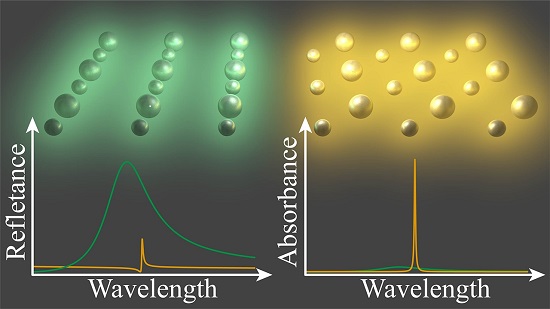A research team from the University of New Mexico (UNM) and the Autonomous University of Madrid has applied periodic arrays containing nanoparticles of different sizes — as opposed to more conventional arrays that contain nanoparticles of a singular, uniform size — to generate coherent light of desired colors.
Receiving a response from nanophotonic applications, such as ultrasensitive biosensing and nanoscale lasing, is contingent upon a spectrally narrow range of colors, or light wavelengths. Systems featuring periodic arrays can attract the desired spectrally narrow responses. The research team’s application delivered increasingly narrow responses.
The responses were additionally more robust to imperfections, particularly in the fabrication process, making the arrays and corresponding responses easier to build and test in a laboratory setting.
“The strength and width of a lattice resonance depends on the number of nanoparticles in the array that are able to interact with one another,” said Alejandro Manjavacas of the Theoretical Nanophotonics Group at the UNM Department of Physics and Astronomy. “Fabrication imperfections such as variations in the size and positioning of the nanoparticles reduce their ability to interact in this way and can therefore destroy the lattice resonance. For lattice resonances supported by arrays composed of particles with only one size, this can mean that arrays with tens or even hundreds of thousands of particles place with very high precision are needed in order to achieve the desired optical response.
“We found that by using two different sizes of nanoparticles in a periodic array, the number of nanoparticles needed to see the same strong and spectrally narrow response is significantly decreased. With the arrays we studied, only a few thousand particles might be needed. This makes their fabrication much easier and more tolerant to imperfections in the particle sizes and positions.”
The robustness of the arrays and resulting tolerance to fabrication imperfections also hold promise in mass production. Manufacturing standards necessary to create a functional device, or system, would not need to be as challenging as for existing arrays.

Receiving a response from nanophotonic applications depends on a spectrally narrow range of light wavelengths, which share varying relationships with levels of both reflectance and absorbance, as shown via a representation of the nanoparticles investigated in the study. Artistic rendering courtesy of University of New Mexico.
Before mass production can commence for the purpose of application(s) in biosensing, however, development must reach a point at which the team is able to design arrays with specific parameters that solicit sensitive responses to the dielectric properties of a surrounding environment, Manjavacas said.
Nanophotonic applications can be applied to the detection of viruses and diseases, and the newly styled arrays have the potential to increase the volume and accuracy of testing, such as that which analysts are currently performing to detect COVID-19. The discovery could also be applied to detect the antibodies produced by the virus, the researchers said. Understanding fully how a surrounding environment modifies their created arrays, including gauging how placing different materials at the top and bottom of the array(s) might affect strength and spectral positioning of lattice resonances, will be among their next steps.
“For biosensing, we want arrays whose responses are very sensitive to tiny changes in the environment, since more sensitivity means that smaller concentrations of viruses or chemicals can be detected,” Manjavacas said. To move toward use in biosensing, team members are now directing their focus to the study of how arrays modify when they are excited by point-like sources (idealized models of atoms, molecules, and/or quantum dots) placed in their vicinity.
Additional nanophotonic applications for the discovery the researchers have identified include solar energy harvesting, high-resolution color printing, and the development of nanoscale light sources.
Domestically, the research was sponsored in part by the National Science Foundation and the Department of Energy Computational Science Graduate Fellowship. From Spain, the Ministry of Economy and Competitiveness, the Ministry for Science and Innovation, and the “María de Maeztu” program for Units of Excellence in R&D also sponsored the work.
The research was published in ACS Nano (www.doi.org/10.1021/acsnano.0c04795).